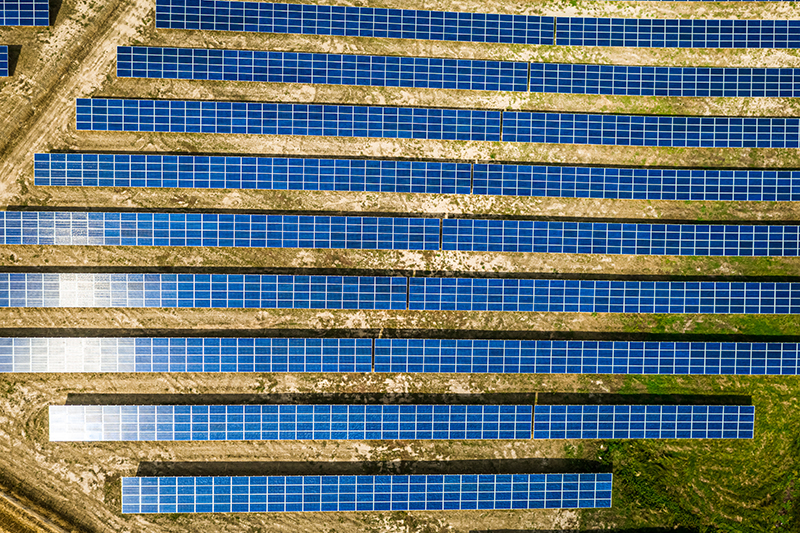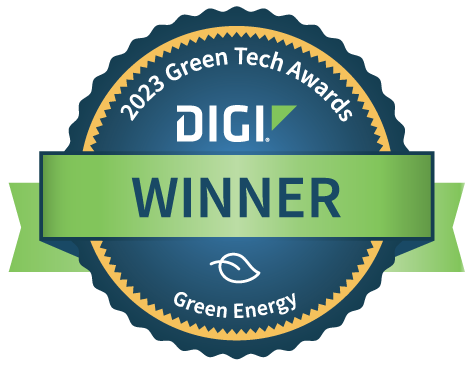 Founded in 1999, P4Q Electronics is a global leader in PV solar tracker controllers. Since its launch in 2007, Suntrack® has been deployed around the world to maximize energy yields, improve the reliability of PV single-axis trackers, and enable customers to remotely monitor, in real-time, solar panel fields around the globe. With Digi XBee® 3 Zigbee connectivity, the green energy company keeps a close eye on more than 1,150 PV solar sites worldwide.
Founded in 1999, P4Q Electronics is a global leader in PV solar tracker controllers. Since its launch in 2007, Suntrack® has been deployed around the world to maximize energy yields, improve the reliability of PV single-axis trackers, and enable customers to remotely monitor, in real-time, solar panel fields around the globe. With Digi XBee® 3 Zigbee connectivity, the green energy company keeps a close eye on more than 1,150 PV solar sites worldwide.
Turning to the Sun
 Around the world, a rapidly growing number of solar panels are continuously capturing sunlight and converting it into clean electricity. While that’s helping address the repercussions of fossil fuels and climate change, leaders in the solar-power field are steadfast in their pursuit of new efficiencies to maximize the applicable power of the sun. One strategy: carefully and continually re-aiming photovoltaic solar panels throughout the day to maximize their direct exposure to the sun’s rays.
Around the world, a rapidly growing number of solar panels are continuously capturing sunlight and converting it into clean electricity. While that’s helping address the repercussions of fossil fuels and climate change, leaders in the solar-power field are steadfast in their pursuit of new efficiencies to maximize the applicable power of the sun. One strategy: carefully and continually re-aiming photovoltaic solar panels throughout the day to maximize their direct exposure to the sun’s rays.
P4Q Electronics has emerged as the world’s leading provider of solar-tracking control systems, thanks to its innovative Suntrack solution. Using sophisticated algorithms that can pinpoint the sun’s location by date and time and factor in weather forecasts, Suntrack communicates with a tracker control unit beneath the panel to carefully readjust the solar panel to the optimal position.
When you operate a solar farm of hundreds or thousands of panels, wireless data connectivity becomes a prime consideration. “We wanted a reliable wireless communication technology that could stand up to the harsh environments of utility-scale solar plants,” said Noemí Pérez, commercial director for P4Q Electronics. “We knew that we’d need to manage and transmit large amounts of data in real time to help our customers maximize the availability of the solar plant.”
.png?lang=en-US)
Zigbee’s the Choice for Effective, Reliable Communication
P4Q conducted a thorough market survey to study its networking options. “We investigated at least 10 different alternatives that could potentially meet our needs,” Pérez explained. “Our comparisons found that Zigbee was consistently the most effective and reliable option, based on distance/reach, data rates, and energy consumption. We evaluated several mesh protocols (including Zigbee, LowPan, and Wirepass) and point-to-point wireless technologies (such as LORA, Sigfox, and NB-IoT). Zigbee was clearly superior, providing the best balance in industrial environments.”
To supply the connectivity component to Suntrack, P4Q selected the Digi XBee® 3 Zigbee 3.0 module that adds connectivity in a compact, low-power, low-profile footprint. Digi XBee 3 modules accelerate time-to-market for designers, OEMs and solution providers by quickly enabling wireless connectivity and easy-to-add functionality. Building on industry-leading technology, pre-certified Digi XBee 3 offers the flexibility to switch between multiple frequencies and wireless protocols as needed.
“Digi XBee is the dominant worldwide supplier of Zigbee solutions,” said Pérez, “so we were very confident the company could meet our technical requirements and volume demands.”
Maximizing the Solar Plant
.png?lang=en-US)
P4Q’s Suntrack primarily uses the Digi XBee 3 module within its integrated Tracker Control Unit, carrying data at 2.4 GHz speeds. All of the functionality is housed in a rugged enclosure that contains the power unit, motor driver, and a micro-controller device. The unit uses updates from P4Q’s proprietary algorithm and, using the solar tracker’s motor, rotates and adjusts the position of the panels to optimize its exposure to the sun on that day.
Suntrack also features a Network Control Unit (NCU) and Remote Sensor Units (RSU), both of which integrate the XBee modules.
The NCU is an electric cabinet that reads and centralizes the main data from the trackers: the positions of the axes, target position and the principal alarms that determine if the trackers are working properly. This provides the option to access any of the trackers connected to it remotely.
The RSU allows the user to monitor solar site atmospheric variables that could result in hazards for the trackers' structures, such as wind speed, snow and flood levels. Alarms transmitted by the RSU are treated by the Network Controller Unit (NCU).
.png?lang=en-US)
“Currently, our solution is installed at more than 1,150 PV solar sites worldwide,” said Pérez. “That’s more than 650,000 devices with capacity of more than 25 GW of electricity. As you can imagine, that translates into massive data volumes. We’re managing 2 TB of information from our customers, and we enable them to securely access that through our customer portal on a 24x7 basis."
She added, “Digi helps us in our transition from wired to wireless communications in our customers’ solar plants, and that’s helping us bring innovative change to a fast-growing industry.”
Connect with Digi
Seeking next-generation solutions and support? Here are some next steps: